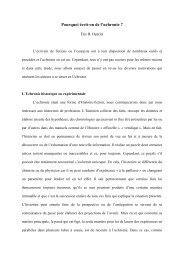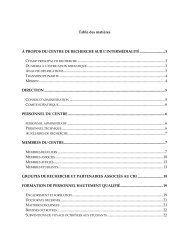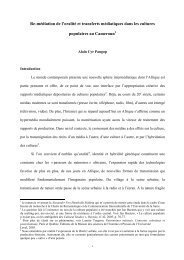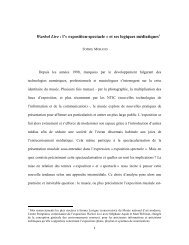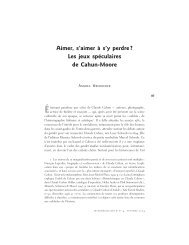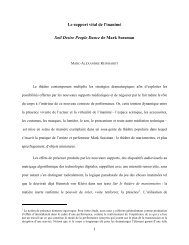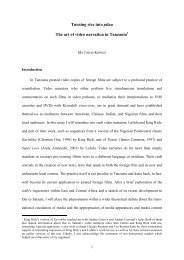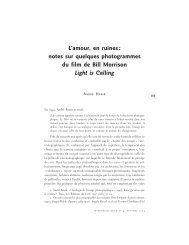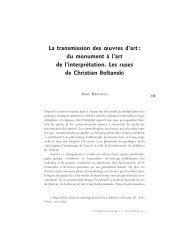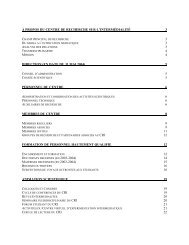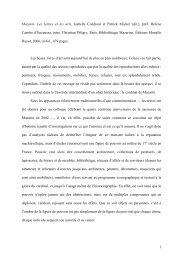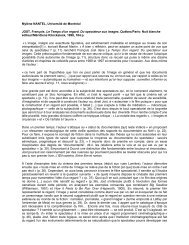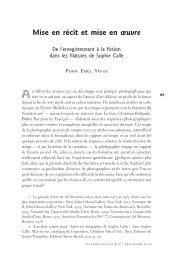Intermediality - Centre de recherche sur l'intermédialité (CRI ...
Intermediality - Centre de recherche sur l'intermédialité (CRI ...
Intermediality - Centre de recherche sur l'intermédialité (CRI ...
You also want an ePaper? Increase the reach of your titles
YUMPU automatically turns print PDFs into web optimized ePapers that Google loves.
intermediality, intertextuality, and remediation<br />
ical phrases as “fi lmic writing” or “musicalization of literature,” phrases which<br />
strongly infl uenced the literary <strong>de</strong>bate on relations between media before the<br />
advent of the concept of intermediality.<br />
Just as a literary text can evoke or imitate specifi c elements or structures of<br />
fi lm, music, theatre, etc., so fi lms, theatrical performances, or other media products<br />
can constitute themselves in various complex ways in relation to another<br />
medium. In a particularly impressive way such a “putting into relation” of one<br />
medium and another has, to give just one example, been realized in the dance<br />
theatre production Körper (Bodies) by Sasha Waltz (Berlin, 2000; fi g. 1-2). At a<br />
certain point of the piece a huge picture-frame-like construction is erected on<br />
the stage, equipped with a transparent front and an opaque panel in the back.<br />
Stuck between the transparent front-pane and the back-panel and supporting<br />
themselves in the air by pressing their limbs against the two “walls,” the dancers<br />
move very slowly, head up and head down, in every possible direction; seemingly<br />
weightless and as if freed from the necessity to touch ground. With several other<br />
factors contributing to its overall effect (a particular lighting, the dancers’ costumes<br />
recalling loincloths, bodies seemingly cut off at the bor<strong>de</strong>rs of the frame,<br />
etc.), this sequence as a whole inevitably reminds the viewer of a painting, maybe<br />
even more specifi cally of a mannerist one.<br />
Here, in fact, the means and instruments of dance theatre (bodies, costumes,<br />
movements, lighting, stage props, etc.) are employed and fashioned in<br />
a way that corresponds to, and resembles, elements, structures and representational<br />
practices of painting, thus creating an illusion of painterly qualities. (Put<br />
in cognitivist terms, they cue the spectator to apply painting-bound schemata).<br />
The evocation of the medium of painting is not achieved simply by means of<br />
subjective associations that may (or may not) be elicited in the viewer’s mind.<br />
Rather, the placement onstage of an oversized frame—a <strong>de</strong>vice that is iconically<br />
related to a picture frame, and that effectively “frames” the action taking place<br />
onstage—explicitly <strong>de</strong>signates painting as the medial system being referred to,<br />
and thus marks the overall mise-en-scène as an intermedial reference to painting.<br />
Hence, the sequence as a whole constitutes itself (and is “received” by the viewer)<br />
in relation to painting, imitating, but at the same time—as is typical of intermedial<br />
references of this kind—also expanding the representational mo<strong>de</strong>s of the<br />
medium being referred to (for instance, Körper supplements the stasis of painting<br />
with the movement of the dancers): it is as if the viewer sees a painting put into<br />
motion, turned to life—a tableau vivant in the truest sense of the term.<br />
The oversized frame in Körper is not only of interest in itself (and in its<br />
function as a marker), but also because its use onstage makes particularly evi<strong>de</strong>nt<br />
57



